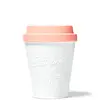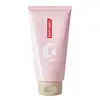What's inside
What's inside
 Key Ingredients
Key Ingredients

No key ingredients
 Benefits
Benefits

 Concerns
Concerns

 Ingredients Side-by-side
Ingredients Side-by-side

Water
Skin ConditioningCaprylic/Capric Triglyceride
MaskingCarthamus Tinctorius Seed Oil
MaskingGlyceryl Stearate Citrate
EmollientLauryl Laurate
Skin ConditioningGlyceryl Stearate Se
EmulsifyingGlycerin
HumectantCetearyl Alcohol
EmollientButyrospermum Parkii Butter
Skin ConditioningTheobroma Cacao Seed Butter
EmollientParfum
MaskingCaprylyl Glycol
EmollientCaffeine
Skin ConditioningMica
Cosmetic ColorantCI 77891
Cosmetic ColorantCoffea Arabica Seed Extract
MaskingAcrylates/C10-30 Alkyl Acrylate Crosspolymer
Emulsion StabilisingCaprylhydroxamic Acid
Euterpe Oleracea Fruit Oil
Skin ConditioningSodium Hydroxide
BufferingNephelium Longana Seed Extract
Skin ConditioningTrisodium Ethylenediamine Disuccinate
Citric Acid
BufferingWater, Caprylic/Capric Triglyceride, Carthamus Tinctorius Seed Oil, Glyceryl Stearate Citrate, Lauryl Laurate, Glyceryl Stearate Se, Glycerin, Cetearyl Alcohol, Butyrospermum Parkii Butter, Theobroma Cacao Seed Butter, Parfum, Caprylyl Glycol, Caffeine, Mica, CI 77891, Coffea Arabica Seed Extract, Acrylates/C10-30 Alkyl Acrylate Crosspolymer, Caprylhydroxamic Acid, Euterpe Oleracea Fruit Oil, Sodium Hydroxide, Nephelium Longana Seed Extract, Trisodium Ethylenediamine Disuccinate, Citric Acid
Water
Skin ConditioningDimethicone
EmollientNeopentyl Glycol Diheptanoate
EmollientIsononyl Isononanoate
EmollientCetearyl Alcohol
EmollientButylene Glycol
HumectantPropanediol
SolventGlycerin
HumectantOlea Europaea Fruit Oil
MaskingPEG-40 Hydrogenated Castor Oil
EmulsifyingButyrospermum Parkii Butter
Skin ConditioningHydrogenated Olive Oil
Skin ConditioningOlea Europaea Oil Unsaponifiables
Skin ConditioningMica
Cosmetic ColorantEvodia Rutaecarpa Fruit Extract
Skin ConditioningTamarindus Indica Fruit Extract
Skin ConditioningAlaria Esculenta Extract
Skin ProtectingCereus Grandiflorus Flower Extract
Skin ConditioningOpuntia Tuna Flower/Stem Extract
Skin ConditioningYucca Schidigera Leaf/Root/Stem Extract
CleansingCetearyl Glucoside
EmulsifyingCaprylyl Glycol
EmollientCaprylic/Capric Triglyceride
MaskingPotassium Cetyl Phosphate
EmulsifyingSodium Polyacrylate
AbsorbentHydrogenated Polydecene
EmollientCaprylhydroxamic Acid
Xanthan Gum
EmulsifyingSodium Hydroxide
BufferingPPG-5-Laureth-5
EmollientCitric Acid
BufferingTin Oxide
AbrasiveAcrylates/C10-30 Alkyl Acrylate Crosspolymer
Emulsion StabilisingParfum
MaskingLinalool
PerfumingCitronellol
PerfumingGeraniol
PerfumingHydroxycitronellal
PerfumingLimonene
PerfumingCI 77891
Cosmetic ColorantWater, Dimethicone, Neopentyl Glycol Diheptanoate, Isononyl Isononanoate, Cetearyl Alcohol, Butylene Glycol, Propanediol, Glycerin, Olea Europaea Fruit Oil, PEG-40 Hydrogenated Castor Oil, Butyrospermum Parkii Butter, Hydrogenated Olive Oil, Olea Europaea Oil Unsaponifiables, Mica, Evodia Rutaecarpa Fruit Extract, Tamarindus Indica Fruit Extract, Alaria Esculenta Extract, Cereus Grandiflorus Flower Extract, Opuntia Tuna Flower/Stem Extract, Yucca Schidigera Leaf/Root/Stem Extract, Cetearyl Glucoside, Caprylyl Glycol, Caprylic/Capric Triglyceride, Potassium Cetyl Phosphate, Sodium Polyacrylate, Hydrogenated Polydecene, Caprylhydroxamic Acid, Xanthan Gum, Sodium Hydroxide, PPG-5-Laureth-5, Citric Acid, Tin Oxide, Acrylates/C10-30 Alkyl Acrylate Crosspolymer, Parfum, Linalool, Citronellol, Geraniol, Hydroxycitronellal, Limonene, CI 77891
Ingredients Explained
These ingredients are found in both products.
Ingredients higher up in an ingredient list are typically present in a larger amount.
Acrylates/C10-30 Alkyl Acrylate Crosspolymer is a synthetic polymer. It is used to thicken and improve the texture of products. Due to its properties, it can prevent water and oil ingredients from separating.
This ingredient is also known as shea butter. It is an effective skin hydrator and emollient.
Emollients help soothe and soften your skin. It does this by creating a protective film on your skin. This barrier helps trap moisture and keeps your skin hydrated. Emollients may be effective at treating dry or itchy skin.
Shea butter is rich in antioxidants. Antioxidants help fight free-radicals, or molecules that may harm the body. It is also full of fatty acids including stearic acid and linoleic acid. These acids help replenish the skin and keep skin moisturized.
While Shea Butter has an SPF rating of about 3-4, it is not a sunscreen replacement.
Shea butter may not be fungal acne safe. We recommend speaking with a professional if you have any concerns.
Learn more about Butyrospermum Parkii ButterCaprylhydroxamic Acid is a chelating agent.
Chelating agents help prevent metal ions from binding to other ingredients. This helps prevent unwanted reactions and effects from using the product.
Caprylhydroxamic Acid is often used with natural antimicrobial products as an alternative to preservatives.
Learn more about Caprylhydroxamic AcidThis ingredient is an emollient, solvent, and texture enhancer. It is considered a skin-softener by helping the skin prevent moisture loss.
It helps thicken a product's formula and makes it easier to spread by dissolving clumping compounds.
Caprylic Triglyceride is made by combining glycerin with coconut oil, forming a clear liquid.
While there is an assumption Caprylic Triglyceride can clog pores due to it being derived from coconut oil, there is no research supporting this.
Learn more about Caprylic/Capric TriglycerideCaprylyl Glycol is a humectant and emollient, meaning it attracts and preserves moisture.
It is a common ingredient in many products, especially those designed to hydrate skin. The primary benefits are retaining moisture, skin softening, and promoting a healthy skin barrier.
Though Caprylyl Glycol is an alcohol derived from fatty acids, it is not the kind that can dry out skin.
This ingredient is also used as a preservative to extend the life of products. It has slight antimicrobial properties.
Learn more about Caprylyl GlycolCetearyl alcohol is a mixture of two fatty alcohols: cetyl alcohol and stearyl alcohol. It is mainly used as an emulsifier. Emulsifiers help prevent the separation of oils and products. Due to its composition, it can also be used to thicken a product or help create foam.
Cetearyl alcohol is an emollient. Emollients help soothe and hydrate the skin by trapping moisture.
Studies show Cetearyl alcohol is non-toxic and non-irritating. The FDA allows products labeled "alcohol-free" to have fatty alcohols.
This ingredient is usually derived from plant oils such as palm, vegetable, or coconut oils. There is debate on whether this ingredient will cause acne.
Due to the fatty acid base, this ingredient may not be Malassezia folliculitis safe.
Learn more about Cetearyl AlcoholCi 77891 is a white pigment from Titanium dioxide. It is naturally found in minerals such as rutile and ilmenite.
It's main function is to add a white color to cosmetics. It can also be mixed with other colors to create different shades.
Ci 77891 is commonly found in sunscreens due to its ability to block UV rays.
Learn more about CI 77891Citric Acid is an alpha hydroxy acid (AHA) naturally found in citrus fruits like oranges, lemons, and limes.
Like other AHAs, citric acid can exfoliate skin by breaking down the bonds that hold dead skin cells together. This helps reveal smoother and brighter skin underneath.
However, this exfoliating effect only happens at high concentrations (20%) which can be hard to find in cosmetic products.
Due to this, citric acid is usually included in small amounts as a pH adjuster. This helps keep products slightly more acidic and compatible with skin's natural pH.
In skincare formulas, citric acid can:
While it can provide some skin benefits, research shows lactic acid and glycolic acid are generally more effective and less irritating exfoliants.
Most citric acid used in skincare today is made by fermenting sugars (usually from molasses). This synthetic version is identical to the natural citrus form but easier to stabilize and use in formulations.
Read more about some other popular AHA's here:
Learn more about Citric AcidGlycerin is already naturally found in your skin. It helps moisturize and protect your skin.
A study from 2016 found glycerin to be more effective as a humectant than AHAs and hyaluronic acid.
As a humectant, it helps the skin stay hydrated by pulling moisture to your skin. The low molecular weight of glycerin allows it to pull moisture into the deeper layers of your skin.
Hydrated skin improves your skin barrier; Your skin barrier helps protect against irritants and bacteria.
Glycerin has also been found to have antimicrobial and antiviral properties. Due to these properties, glycerin is often used in wound and burn treatments.
In cosmetics, glycerin is usually derived from plants such as soybean or palm. However, it can also be sourced from animals, such as tallow or animal fat.
This ingredient is organic, colorless, odorless, and non-toxic.
Glycerin is the name for this ingredient in American English. British English uses Glycerol/Glycerine.
Learn more about GlycerinMica is a naturally occurring mineral used to add shimmer and color in cosmetics. It can also help improve the texture of a product or give it an opaque, white/silver color.
Serecite is the name for very fine but ragged grains of mica.
This ingredient is often coated with metal oxides like titanium dioxide. Trace amounts of heavy metals may be found in mica, but these metals are not harmful in our personal products.
Mica has been used since prehistoric times throughout the world. Ancient Egyptian, Indian, Greek, Roman, Aztec, and Chinese civilizations have used mica.
Learn more about MicaParfum is a catch-all term for an ingredient or more that is used to give a scent to products.
Also called "fragrance", this ingredient can be a blend of hundreds of chemicals or plant oils. This means every product with "fragrance" or "parfum" in the ingredients list is a different mixture.
For instance, Habanolide is a proprietary trade name for a specific aroma chemical. When used as a fragrance ingredient in cosmetics, most aroma chemicals fall under the broad labeling category of “FRAGRANCE” or “PARFUM” according to EU and US regulations.
The term 'parfum' or 'fragrance' is not regulated in many countries. In many cases, it is up to the brand to define this term.
For instance, many brands choose to label themselves as "fragrance-free" because they are not using synthetic fragrances. However, their products may still contain ingredients such as essential oils that are considered a fragrance by INCI standards.
One example is Calendula flower extract. Calendula is an essential oil that still imparts a scent or 'fragrance'.
Depending on the blend, the ingredients in the mixture can cause allergies and sensitivities on the skin. Some ingredients that are known EU allergens include linalool and citronellol.
Parfum can also be used to mask or cover an unpleasant scent.
The bottom line is: not all fragrances/parfum/ingredients are created equally. If you are worried about fragrances, we recommend taking a closer look at an ingredient. And of course, we always recommend speaking with a professional.
Learn more about ParfumSodium Hydroxide is also known as lye or caustic soda. It is used to adjust the pH of products; many ingredients require a specific pH to be effective.
In small amounts, sodium hydroxide is considered safe to use. However, large amounts may cause chemical burns due to its high alkaline.
Your skin has a natural pH and acid mantle. This acid mantle helps prevent harmful bacteria from breaking through. The acid mantle also helps keep your skin hydrated.
"Alkaline" refers to a high pH level. A low pH level would be considered acidic.
Learn more about Sodium HydroxideWater. It's the most common cosmetic ingredient of all. You'll usually see it at the top of ingredient lists, meaning that it makes up the largest part of the product.
So why is it so popular? Water most often acts as a solvent - this means that it helps dissolve other ingredients into the formulation.
You'll also recognize water as that liquid we all need to stay alive. If you see this, drink a glass of water. Stay hydrated!
Learn more about Water